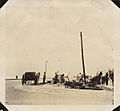Galveston Seawall facts for kids
|
Galveston Seawall
|
|

Galveston Seawall during construction
|
|
| Location | Seawall Blvd., Galveston, Texas |
|---|---|
| Area | 8 acres (3.2 ha) |
| Built | 1902 |
| Built by | J.M. O`Rourke & Co. |
| Architect | Gen. H.M. Robert |
| Architectural style | Protective Seawall |
| NRHP reference No. | 77001443 |
Quick facts for kids Significant dates |
|
| Added to NRHP | August 18, 1977 |
The Galveston Seawall is a huge wall built along the coast in Galveston, Texas. It was constructed after a terrible storm, the Galveston Hurricane of 1900, hit the city in 1900. This massive wall was designed to protect Galveston from future powerful storms, like hurricanes. Building the first part of the seawall started in September 1902 and finished in July 1904. Over many years, from 1904 to 1963, the seawall grew from about 3.3 miles (5.3 km) to over 10 miles (16 km) long!
Contents
Why the Seawall Was Built
The Galveston Hurricane of 1900 was one of the deadliest natural disasters in U.S. history. It caused huge damage and many lives were lost. To prevent such a disaster from happening again, the people of Galveston decided they needed a strong barrier. This barrier would protect the city from the powerful waves and storm surges of future hurricanes.
How the Seawall Changed Galveston
The seawall did its job well, protecting the city from many storms. However, it also caused an unexpected problem. Over time, the wide sandy beaches that Galveston was famous for began to disappear. The seawall stopped the natural flow of sand, causing the beach to erode. This made the beach much narrower, which affected the city's tourism business.
Protecting Against Future Storms
The seawall has saved Galveston from a lot of damage over the years. For example, after Hurricane Alicia in 1983, experts estimated that the seawall prevented about $100 million in damage.
In 2008, Hurricane Ike brought huge waves and a storm surge that went over the seawall. This showed that even with the seawall, Galveston still faces risks from very strong hurricanes. After Hurricane Ike, the Texas governor created a group to study how to better prepare for and prevent future storm damage.
The Ike Dike Idea
One big idea that came from this study is to build something called the "Ike Dike". This would be a giant levee system. Its goal is to protect Galveston Bay and the important factories and shipping lanes along the coast. This project is still being planned. Other ideas include smaller, local levees and natural ways to protect the coast.
Fun Facts About the Seawall
The Galveston Seawall is about 10 miles (16 km) long. It stands about 17 feet (5.2 meters) high and is 16 feet (4.9 meters) thick at its base.
The sidewalk that runs along the top of the seawall is very long. It's about 10.3 miles (16.6 km) long! Some people say it's the longest continuous sidewalk in the world.
Many parts of the seawall are covered in colorful murals. These large paintings are often created by children and show amazing underwater scenes and sea creatures.
The seawall is not just a protective barrier; it's also a historic landmark. It was added to the National Register of Historic Places in 1977. In 2001, it was named a National Civil Engineering Landmark. This shows how important and impressive this engineering project is.
Gallery
-
Workers repairing Seawall Boulevard after 1915 Galveston Hurricane.









